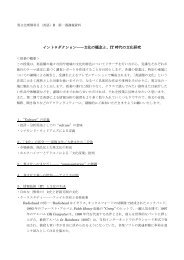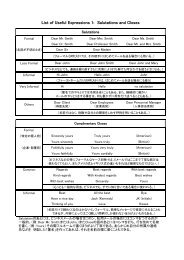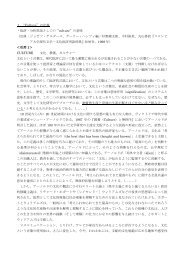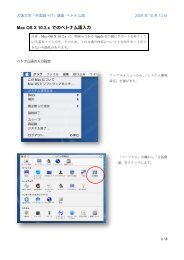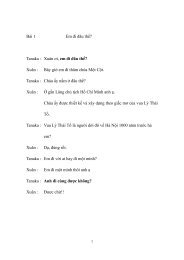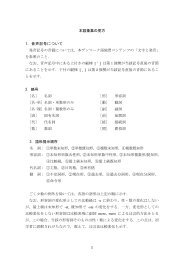4 - 大阪大学世界言語eラーニングサーバ
4 - 大阪大学世界言語eラーニングサーバ
4 - 大阪大学世界言語eラーニングサーバ
Create successful ePaper yourself
Turn your PDF publications into a flip-book with our unique Google optimized e-Paper software.
The central symbol for Canada—and this is based on numerous instances of its occurrence in both<br />
English and French Canadian literature—is undoubtedly Survival, la Survivance. Like the Frontier<br />
and The Island, it is a multifaceted and adaptable idea. For early explorers and settlers, it meant<br />
bare survival in the face of “hostile” elements and/or natives: carving out a place an a way of keeping<br />
alive. But the word can also suggest survival of a crisis or disaster, like a hurricane or a wreck, and<br />
many Canadian poems have this kind of survival as a theme; what you might call “grim” survival as<br />
opposed to “bare” survival. For French Canada after the English took over it became cultural<br />
survival, hanging on as a people, retaining a religion and a language under an alien government.<br />
And in English Canada now while the Americans are taking over it is acquiring a similar meaning.<br />
There is another use of the word as well: a survival can be a vestige of a vanished order which has<br />
managed to persist after its time is past, like a primitive reptile. This version crops up in Canadian<br />
thinking too, usually among those who believe that Canada is obsolete.<br />
E. Canadian National Symbol 2: What It Means<br />
But the main idea is the first one: hanging on, staying alive. Canadians are forever taking the<br />
national pulse like doctors at a sickbed: the aim is not to see whether the patient will live well but<br />
simply whether he will live at all. Our central idea is one which generates, not the excitement and<br />
sense of adventure or danger which The Frontier holds out, not the smugness and/or sense of security,<br />
of everything in its place, which The Island can offer, but an almost intolerable anxiety. Our stories<br />
are likely to be tales not of those who made it but of those who made it back from the awful<br />
experience—the North, the snowstorm, the sinking ship—that killed everyone else. The survivor has<br />
no triumph or victory but the fact of his survival; he has little after his ordeal that he did not have<br />
before, except gratitude for having escaped with his life.<br />
Activities<br />
・パラグラフ A~E をよく 読 んでください。まずは 細 かいところは 無 視 して、「 何 について 書 いてあるか」<br />
を 理 解 するように 努 めてください。<br />
・パラグラフ B、C、D をそれぞれのグループに 割 り 当 てますので、じっくり 読 んでください。 英 語 の 表<br />
現 が 分 かりにくいところや、リサーチの 必 要 な 話 題 にチェックを 入 れておいてください。<br />
・グループで 話 し 合 い、 文 章 をどう 解 釈 するかを 決 めて、 発 表 用 の 原 稿 を 作 成 します。 補 足 の 資 料 が 必<br />
要 な 場 合 は、ウェブ 上 でサーチしてみてください。<br />
・Impress を 使 って、 説 明 用 の 簡 単 な 資 料 を 作 成 します。<br />
・ 各 パラグラフについて、クラスの 前 で 発 表 していただきます。<br />
・ 発 表 で 使 用 した Impress のファイルは、 講 師 に 提 出 してください。<br />
※ 講 師 が 各 グループを 回 りますので、コンピュータの 使 い 方 や 資 料 のまとめ 方 その 他 の 質 問 がありまし<br />
たら、 何 でも 聞 いてください。



